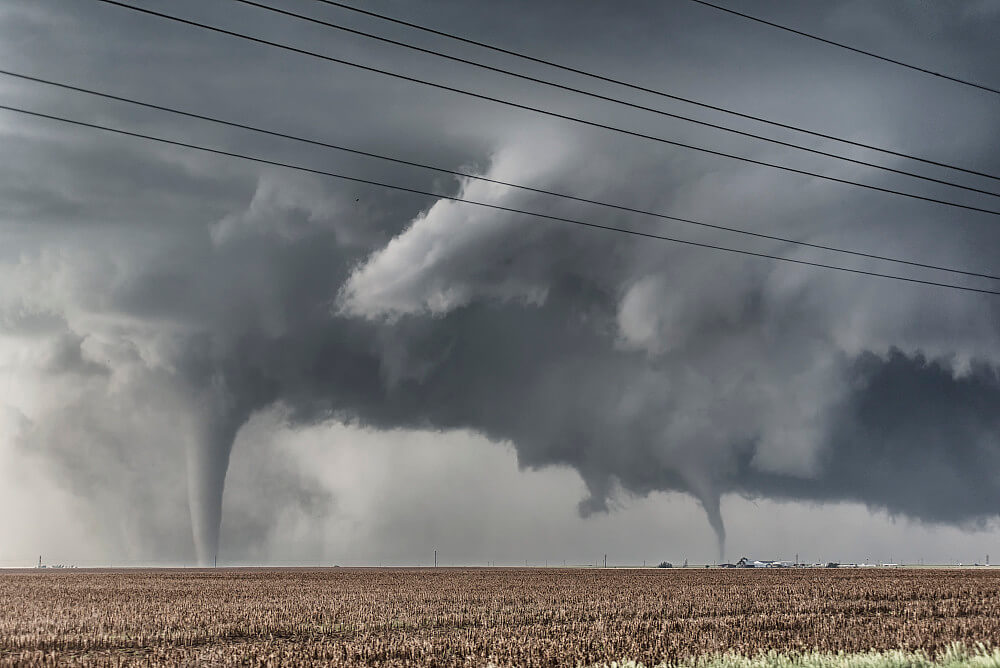Tornadoes are natural weather events that occur mostly in the dry central plains of North America.
They range in strength with some being violent and having powerful 200 – 300mph winds, but most tornadoes are EF0 or EF1 on the Fujita scale and last only minutes.
Nevertheless, a tornado warning is a scary event that affects many US citizens between the summer months of March and July, but tornadoes can happen at any time of year.
Tornadoes mainly cause damage through their powerful winds wrecking homes and throwing debris around neighborhoods.
But a topic that often comes up when discussing these freakish weather events and one we’re going to cover today is “do tornadoes touch the ground?”
YES, all tornadoes DO touch the ground. A vortex that does not touch the ground is instead called a funnel cloud. Whereas, if the funnel cloud does touch down it is then categorized as a tornado.
Let’s take a closer look…
Do Tornadoes Really Touch The Ground?
Tornadoes come from energy stored in thunderstorms. Wind speeds increase and a funnel cloud forms, but when a vortex appears and then makes contact with the ground it is then classified as a tornado.
If the vortex doesn’t touch the ground it is called a funnel cloud. A “tornado” is only really a tornado when the vortex makes contact with the ground.
Most tornadoes begin as funnel clouds then as they progress and grow stronger they ultimately turn into a tornado.
What Causes A Tornado To Touch The Ground?
Supercell thunderstorms are the most powerful on earth and have all the ingredients needed to spawn tornadoes.
As the supercell storm grows in size the vortex in the center will begin to tilt which siphons warm air and moisture upwards and pushes cold dry air towards the ground.
The updraft of warm air begins to swell with water vapor which creates a rotating funnel cloud at its center.
The cool downdraft of air then battles the funnel cloud’s upward spiral which focuses the cloud into a smaller area and increases the speed.
The rapidly expanding funnel cloud is compelled to touch down on the ground by enough weight and pressure from the cool air downdraft, and a tornado is officially born.
Do All Tornadoes Touch The Ground?
YES, a vortex must make contact with the ground for it to be a tornado, therefore, all tornadoes MUST touch the ground.
Water droplets form a condensation funnel that descends from the thunderstorm’s base. It is a tornado if it makes contact with the earth; otherwise, it is a funnel cloud.
If there’s dust and debris beneath the condensation funnel this is also confirmation that you’re looking at a tornado.
Not a cloud, but the wind is what characterizes a tornado. Even strong wind is not always visible.
To be considered a tornado, an air circulation that is destructive at ground level beneath a storm cloud is required. The funnel cloud is an accidental or secondary tornado feature that occasionally does not appear.
How Long Do Tornadoes Touch The Ground?
A tornado’s lifespan when it strikes the ground can range from a few seconds to three hours.
That said, most tornadoes don’t stay on the ground for more than 10 minutes and some can disappear in a matter of seconds.
The typical tornado is 660 feet wide and travels at a speed of 30 miles per hour. Most tornadoes only survive for six miles or less.
According to official statistics, the longest period a tornado was active was 3 hours, 29 minutes. The Tri-State tornado of March 18, 1925.
Do Tornadoes Start From The Ground Or Sky?
Tornadoes are started from within a supercell tornado and gradually make their way down by means of a funnel cloud.
They’re often invisible until they touch the ground, but once they do they begin picking up dirt and debris and hurtling it around in a vortex which makes them visible.
However, there’s new research that is challenging what we currently know about how tornadoes form and suggests that tornadoes actually form from the ground up.
This is still uncertain and is not yet confirmed, but what we do know is that after analyzing El Reno (the widest tornado ever) it was found that the storm’s funnel was already on the ground before the radar data.
This suggests that the tornado may have started to form on the ground, but more research is needed to come up with accurate conclusions.
Final Thoughts
Hopefully, you now have a clear answer to “do tornadoes touch the ground” and have a better understanding of how tornadoes are classified.
ALL tornadoes touch the ground as this is a classification that defines a tornado, whereas vortexes that do not touch the ground are known as cloud funnels.
There’s still lots to learn when it comes to tornadoes and new technology is starting to question what we once thought true about how they form.
It’s now being debated as to whether tornadoes really do form from supercell tornadoes or if they’re actually forming from the ground up.
Either way, these natural weather events are fascinating and the more we understand about them the better we can prepare and ensure our safety.
Thanks for taking the time to read this post and I’ll catch you in the next one!

Hey, I’m Sam – the founder of GustyPlanet. I’ve had a fascination with all things weather for as long as I can remember. I witnessed my first tornado at the age of 6, and since then became an avid storm chaser that is hooked on learning as much as I can about extreme weather. This blog was created to share my knowledge and to expand and delve deeper into the wonderful world of weather phenomena. I hope you enjoy your stay here and thanks for visiting.







